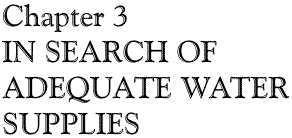
| ch. 3, pp. 25 - 26 |
AUGMENTING THE WATER SUPPLY — RECHARGE In Tucson — in fact, in most of the heavily populated areas of Arizona — depletion of the aquifer is a problem and is the underlying concern for much public policy. Recharge is an important tool in managing groundwater levels in the Tucson area and has attracted much attention from government agencies, university researchers, concerned citizens and others. Passage of the Water Consumer Protection Act in 1995, which directed the City of Tucson to use its CAP water allotment for recharge or to trade with area farms and mines instead of direct delivery to homes, has increased attention paid to development of recharge projects in the area. Recharge generally refers to the addition of water to groundwater already in the aquifer. In order to recharge the aquifer, water usually must first infiltrate the soil or ground surface and then percolate though the unsaturated zone of the aquifer (referred to as the vadose zone) to reach the water table. The water table defines the top part of the aquifer which is saturated with groundwater. An important distinction exists between infiltration and recharge. Infiltration is entry of water into the soil and the movement of water from the soil into the vadose zone. Recharge is addition of water to the part of the aquifer which is saturated with groundwater and can be pumped. Recharge of an aquifer occurs in three ways: natural recharge resulting from precipitation and runoff; incidental recharge from water that seeps into the ground after various human uses, such as irrigation; and artificial recharge by constructed or managed projects designed to put water in the aquifer. These three types of recharge help maintain a balance of water use and supply. Natural Recharge Natural recharge is the addition of precipitation and streamflows to groundwater supplies in the aquifer. Water from precipitation and runoff infiltrates mainly along mountain fronts and in stream channels and also as direct underflow from joints and other openings in rocks. Snowmelt and mountain precipitation often infiltrates at the foot of mountain ranges. Mountain-front recharge in TAMA averages about 39,000 acre-feet annually. Stream channel recharge in the Tucson area occurs as a result of infrequent, but occasionally large stream flow events. Some of the water that flows in streams after heavy rains infiltrates the streambed to recharge the groundwater aquifer. Total stream channel recharge in TAMA averages approximately 38,000 acre-feet per year. (See Chapter 4 for more information.) Underground flow of groundwater also is included in calculating natural recharge to an area. Groundwater generally moves slowly (at a rate of a couple hundred feet per year) to the north and northwest in the Tucson area. On average approximately 9,000 acre-feet per year of groundwater flows underground into TAMA from the south every year and about 25,000 acre-feet per year leaves TAMA by flowing underground to the north. Incidental Recharge Incidental recharge is water that reaches the water table after human use. The amount of incidental recharge in TAMA depends mostly on the extent and water use efficiency of certain human activities, such as irrigated agriculture, mining and the discharge of effluent into stream channels. ADWR has estimated that annual incidental recharge in TAMA totals about 81,000 acre-feet, based on water use levels projected for the year 2000. Most is effluent discharged by the two large wastewater treatment plants. Artificial Recharge Artificial recharge of either CAP water or effluent is an important method of utilizing renewable supplies in TAMA. Artificial groundwater recharge generally involves constructing facilities to control the movement and rate of infiltration. The following discusses artificial recharge as a way of replenishing the aquifer. Using artificial recharge as a water treatment method is discussed in Chapter 6. The State of Arizona’s Underground Water Storage, Savings and Replenishment Program allows two types of recharge facilities: Underground Storage Facilities (USFs) and Groundwater Savings Facilities (GSFs). USFs, or direct recharge facilities, can include “constructed” projects, such as spreading basins, structures placed in a stream channel to increase percolation into the stream bed, or injection wells, as well as “managed” projects, where water is applied to stream channels without constructed facilities (See side bar for discussion of the types of direct recharge facilities). In the case of constructed projects, the rate of application of water is regulated through facility design and operating procedures to control the rate at which water reaches the aquifer and to ensure that quality is not impaired. Through GSFs, or “in lieu” recharge facilities, incentives are provided to encourage farms or other entities to use renewable supplies such as C AP water instead of groundwater. (See Chapter 5 for a discussion of CAP water use by Tucson area farms through GSFs, and Chapter 7 for additional explanation of GSFs and USFs.) A water storage permit holder may choose to recover water in the same calendar year (annual storage and recovery) or to accumulate long-term storage credits. ADWR maintains a long-term storage credit account for each storer. In most cases involving direct recharge of CAP water, storers get credits for 95 percent of the volume of water stored minus evaporation. The state requires the other five percent to remain in the aquifer as permanent recharge. Municipal providers can use long-term storage credits to help meet their Assured Water Supply requirements and to help prove the physical availability of an assured water supply.
|
